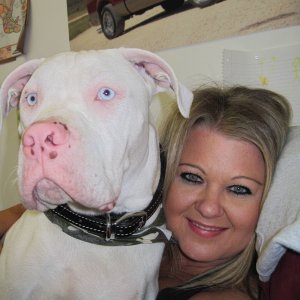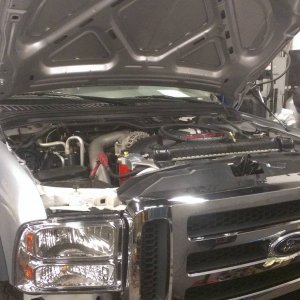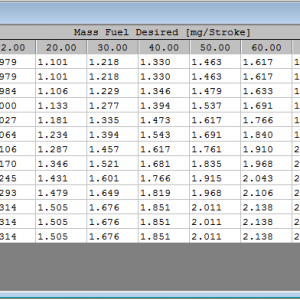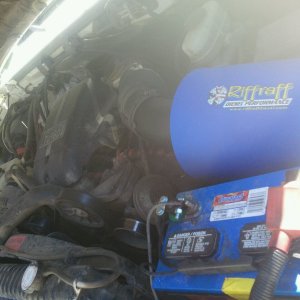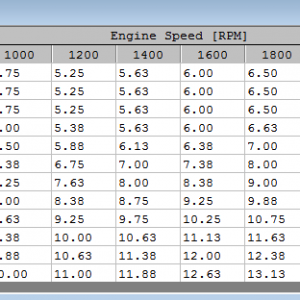Here is some more testing info for you.
For y'alls reference, the bible:
It says, fan engagement may delay 10 seconds to 3 MINUTES when commanded, so a delay is normal, for your pleasure, fan diagnostics:
2004 PCED On Board Diagnostics 6.0L Diesel SECTION 5: Pinpoint Tests
Procedure revision date: 05/24/2004
--------------------------------------------------------------------------------
AH: Visctronic Drive Fan (VDF) AH: Introduction
--------------------------------------------------------------------------------
AH1 PRELIMINARY DIAGNOSIS
Key off.
Carry out the PCM self-test.
Are any DTCs present?
Yes No
For DTC P0480, GO to AH4 .
For DTC P0528, GO to AH3 .
For all other DTCs, REFER to Diagnostic Trouble Code (DTC) Charts, Section 4 . GO to AH2 .
AH2 CHECK THE COOLING FAN FOR MECHANICAL BINDING
Note: The VDF is a viscous coupling. The viscous drag should be smooth during fan rotation. The amount of resistance is dependant upon the final VDF operational state before engine shutdown.
Key off.
Manually rotate the cooling fan.
Does the fan clutch rotation feel rough or binding?
Yes No
INSTALL a new VDF. REFER to the Workshop Manual Section 303 Engine Cooling. GO to AH3 .
AH3 CHECK THE VDF OPERATION
Note: Check and verify the most current PCM calibration level.
Note: Inherent to viscous clutches is a delay in transitioning from a low to a high speed or from a high to a low speed. This delay can vary between 10 seconds and 3 minutes and is dependant upon engine speed and clutch temperature. With the engine at operating temperature and at 2500 RPM, the delay should be less than 30 seconds.
Key on, engine running.
Access Output Test Mode.
Access the FANSS and RPM PIDs.
Increase the engine speed to 2500 RPM.
Monitor the FANSS PID and the VDF duty cycle.
Command the VDF to LOW.
Allow the fan speed to stabilize below 600 RPM.
Command the VDF duty cycle to HIGH.
Does the fan speed change and does the FANSS PID indicate an RPM change?
Yes No
If the FANSS PID stabilizes at less than 2800 RPM with the engine speed at 2500 RPM, INSTALL a new VDF. REFER to the Workshop Manual Section 303 Engine Cooling.
If the FANSS PID stabilizes at greater than 2800 RPM with the engine speed at 2500 RPM, the system is operating correctly.
For cooling system concerns, REFER to the Workshop Manual Section 303 Engine Cooling for diagnosis and testing. If the fan speed did not change, GO to AH4 .
If the fan speed did change and the FANSS PID did not indicate an RPM change, GO to AH12 .
AH4 CHECK THE VDF SOLENOID RESISTANCE
Key off.
Disconnect the VDF.
Measure the resistance between the VDF solenoid VPWR circuit pin 5, component side and the VDF solenoid control circuit pin 4, component side.
Is the resistance between 6.0 and 10.0 ohms?
Yes No
GO to AH5 . INSTALL a new VDF. REFER to the Workshop Manual Section 303 Engine Cooling.
AH5 CHECK THE VDF SOLENOID FOR A SHORT TO GROUND
Measure the resistance between the VDF solenoid control circuit pin 4, component side and ground.
Is the resistance greater than 10,000 ohms?
Yes No
GO to AH6 . INSTALL a new VDF. REFER to the Workshop Manual Section 303 Engine Cooling.
AH6 CHECK THE VDF SOLENOID VPWR CIRCUIT FOR VOLTAGE
Key on, engine off.
Measure the voltage between the VDF solenoid VPWR circuit pin 5, harness side and ground.
Is the voltage greater than 10.5 volts?
Yes No
GO to AH7 . REPAIR the circuit.
AH7 CHECK VDF SOLENOID CONTROL CIRCUIT FOR AN OPEN
Key off.
Disconnect the PCM.
Measure the resistance between the VDF solenoid control circuit pin 4, harness side and the PCM engine connector pin 14, harness side.
Is the resistance less than 5 ohms?
Yes No
GO to AH8 . REPAIR the circuit.
AH8 CHECK THE VDF SOLENOID CONTROL CIRCUIT FOR A SHORT TO GROUND
Measure the resistance between the VDF solenoid control circuit pin 4, harness side and ground.
Is the resistance greater than 10,000 ohms?
Yes No
GO to AH9 . REPAIR the circuit.
AH9 CHECK THE VDF CONTROL CIRCUIT FOR SHORT TO POWER
Key on, engine off.
Measure the voltage between VDF solenoid control circuit pin 4, harness side and ground.
Is any voltage indicated?
Yes No
REPAIR the circuit. INSTALL a new PCM.
AH12 CHECK THE FAN SPEED SENSOR FOR VOLTAGE
Key off.
Disconnect the VDF.
Key on, engine off.
Measure the voltage between the fan speed sensor VREF circuit pin 6, harness side and the fan speed sensor SIGRTN circuit pin 2, harness side.
Is the voltage greater than 10.5 volts?
Yes No
GO to AH17 . GO to AH13 .
AH13 CHECK THE VREF CIRCUIT FOR VOLTAGE
Measure the voltage between the fan speed sensor VREF circuit pin 6, harness side and ground.
Is the voltage greater than 10.5 volts?
Yes No
GO to AH16 . GO to AH14 .
AH14 CHECK THE VREF CIRCUIT FOR AN OPEN
Key off
Disconnect the PCM.
Measure the resistance between the fan speed sensor VREF circuit pin 6, harness side and the PCM engine connector pin 46, harness side.
Is resistance less than 5 ohms?
Yes No
GO to AH15 . REPAIR the circuit.
AH15 CHECK THE VREF CIRCUIT FOR A SHORT TO GROUND
Key off
Disconnect the PCM.
Measure the resistance between the fan speed sensor VREF circuit pin 6, harness side and ground.
Is the resistance greater than 10,000 ohms?
Yes No
INSTALL a new PCM. REPAIR the circuit.
AH16 CHECK THE FAN SPEED SENSOR SIGRTN CIRCUIT FOR AN OPEN
Key off.
Disconnect the PCM.
Measure the resistance between the fan speed sensor SIGRTN circuit pin 2, harness side and the PCM engine connector pin 22, harness side.
Is the resistance less than 5 ohms?
Yes No
INSTALL a new PCM. REPAIR the circuit.
AH17 CHECK THE FAN SPEED SENSOR SIGNAL CIRCUIT FOR AN OPEN
Key off.
Disconnect the PCM.
Measure the resistance between the fan speed sensor signal circuit pin 1, harness side and the PCM engine connector pin 6, harness side.
Is the resistance less than 5 ohms?
Yes No
GO to AH18 . REPAIR the circuit.
AH18 CHECK THE SIGNAL CIRCUIT FOR A SHORT TO GROUND
Measure the resistance between the fan speed sensor signal circuit pin 1, harness side and ground.
Is the resistance greater than 10,000 ohms?
Yes No
GO to AH19 . REPAIR the circuit.
AH19 CHECK THE SIGNAL CIRCUIT FOR A SHORT VOLTAGE
Key on, engine off.
Measure the voltage between the fan speed sensor signal circuit pin 1, harness side and ground.
Is any voltage indicated?
Yes No
REPAIR the circuit. GO to AH20 .
AH20 CHECK THE SIGNAL CIRCUIT FOR VOLTAGE
Key off.
Reconnect the PCM.
Key on, engine off.
Measure the voltage between the fan speed sensor signal circuit pin 1, harness side and ground.
Is the voltage greater than 10 volts?
Yes No
INSTALL a new VDF. REFER to the Workshop Manual Section 303 Engine Cooling. INSTALL a new PCM.
--------------------------------------------------------------------------------


